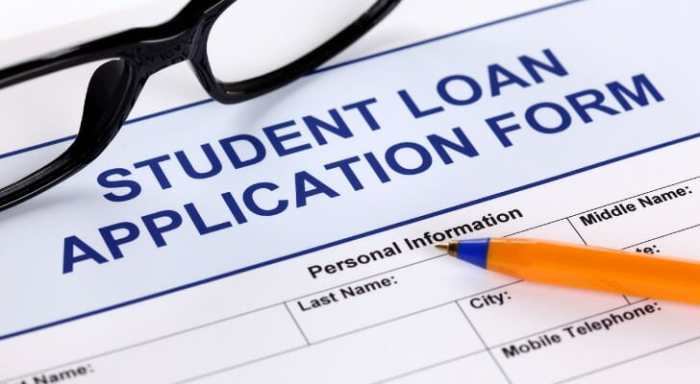
The daunting task of repaying student loans often leaves graduates feeling overwhelmed. Understanding the nuances of repayment options, specifically the differences between installment plans and revolving credit, is crucial for long-term financial health. This guide explores the various approaches to managing student loan debt, weighing the pros and cons of each, and offering practical strategies for effective repayment.
From fixed versus variable interest rates on installment plans to the potential pitfalls of using revolving credit, we’ll delve into the complexities of student loan repayment. We will equip you with the knowledge to make informed decisions, create a personalized repayment plan, and ultimately achieve financial freedom.
Understanding Student Loan Installment Plans
Choosing the right student loan repayment plan is crucial for managing your debt effectively and minimizing long-term costs. Understanding the various options available and their implications is key to making an informed decision. This section will explore different installment plans, the factors influencing plan selection, and the differences between fixed and variable interest rates.
Types of Student Loan Installment Plans
Several types of federal student loan repayment plans cater to different financial situations and repayment preferences. These plans offer varying repayment periods and monthly payments, impacting the total interest paid over the life of the loan. Common plans include Standard Repayment, Extended Repayment, Graduated Repayment, and Income-Driven Repayment (IDR) plans. Each plan has unique characteristics that should be carefully considered.
Factors Influencing the Choice of an Installment Plan
The optimal student loan installment plan depends on several interconnected factors. Interest rates directly impact the total repayment amount. Lower interest rates translate to lower overall costs. The repayment period, or loan term, significantly affects monthly payments and total interest paid. Longer repayment periods result in lower monthly payments but higher total interest. Your current financial situation and anticipated future income also play a crucial role. Income-driven repayment plans, for instance, adjust monthly payments based on your income and family size. Finally, your risk tolerance and long-term financial goals should be carefully weighed.
Fixed vs. Variable Interest Rates in Installment Plans
Fixed interest rates remain constant throughout the loan’s life, providing predictability in monthly payments. This offers stability in budgeting and financial planning. Variable interest rates, on the other hand, fluctuate based on market indices, potentially leading to changes in monthly payments. While variable rates may initially offer lower interest rates, the uncertainty of future rate increases poses a risk. Choosing between fixed and variable rates depends on your risk tolerance and financial outlook. A conservative approach favors fixed rates for their stability, while a more aggressive strategy might consider variable rates if the potential for lower initial interest outweighs the risk of future rate hikes.
Comparison of Student Loan Installment Plans
| Plan Type | Repayment Period | Payment Calculation | Pros | Cons |
|---|---|---|---|---|
| Standard Repayment | 10 years | Fixed monthly payment | Predictable payments, relatively short repayment period | Potentially high monthly payments |
| Extended Repayment | Up to 25 years | Fixed monthly payment | Lower monthly payments | Significantly higher total interest paid |
| Graduated Repayment | 10 years | Payments increase over time | Lower initial payments | Payments can become significantly higher later in the repayment period |
Exploring Revolving Credit for Student Loans
While installment loans are the traditional approach to repaying student loans, revolving credit options, similar to credit cards, present an alternative, albeit one that requires careful consideration. Understanding the nuances of revolving credit in the context of student loan repayment is crucial for making informed financial decisions. This section explores the potential benefits and significant risks associated with this approach.
Revolving credit for student loans allows borrowers to make minimum payments and potentially borrow additional funds up to a credit limit. This flexibility can be attractive, but it’s crucial to understand the implications before utilizing such options. Unlike fixed installment loans with a predetermined repayment schedule, revolving credit involves ongoing interest accrual and the potential for accumulating significant debt if not managed responsibly.
Potential Benefits and Drawbacks of Revolving Credit for Student Loan Repayment
The use of revolving credit for student loan repayment presents both advantages and disadvantages that must be carefully weighed. A responsible approach is essential to prevent the accumulation of substantial debt and high interest charges.
- Potential Benefit: Flexibility. Revolving credit offers flexibility in repayment. Borrowers can adjust their payments based on their financial situation, potentially making larger payments during periods of higher income and smaller payments during times of financial hardship. However, this flexibility can be a double-edged sword, leading to prolonged repayment and increased interest costs if not managed properly.
- Potential Drawback: High Interest Rates. Revolving credit lines, such as credit cards specifically designed for student loan refinancing, often carry higher interest rates than traditional student loans. This can significantly increase the total cost of repayment over time, potentially exceeding the initial loan amount substantially. For example, a $10,000 loan with a 15% APR could result in thousands of dollars in additional interest paid over several years, compared to a fixed-rate loan with a lower interest rate.
- Potential Benefit: Debt Consolidation. In some cases, revolving credit can be used to consolidate multiple student loans into a single payment, simplifying the repayment process. This can be particularly helpful for individuals with multiple loans from different lenders with varying interest rates. However, consolidating into a higher-interest revolving credit line could ultimately increase the total cost of borrowing.
- Potential Drawback: Risk of Overspending. The readily available credit limit associated with revolving credit can tempt borrowers to overspend. This can lead to accumulating even more debt, making repayment even more challenging. A budget and disciplined spending habits are crucial to avoid this pitfall.
Risks Associated with Using Revolving Credit for Student Loans
The primary risk associated with using revolving credit for student loan repayment is the potential for accumulating significant debt and paying substantially more in interest than with a fixed-rate loan. High interest rates, coupled with the temptation to overspend or make only minimum payments, can quickly lead to a debt spiral that is difficult to escape. This can negatively impact credit scores and overall financial health. For instance, consistently making only minimum payments on a high-interest revolving credit line can prolong repayment for many years and lead to thousands of dollars in additional interest charges.
Impact of Installment vs. Revolving Loan Structures

Choosing between an installment loan and a revolving credit option for student loans significantly impacts your long-term financial health. Understanding the differences in repayment structures and interest accrual is crucial for making an informed decision. This section will compare and contrast these two approaches, highlighting their respective advantages and disadvantages through hypothetical examples.
Repayment Schedules and Interest Accrual
Installment loans feature a fixed repayment schedule with a predetermined number of payments over a set period. Each payment typically covers a portion of the principal and the interest accrued on the remaining balance. Revolving credit, on the other hand, offers more flexibility. You make minimum payments, but you can pay more at any time, and you can borrow again up to your credit limit. However, interest accrues on the outstanding balance, potentially leading to a longer repayment period and higher overall interest costs if not managed carefully. The key difference lies in the predictability of repayment: installment loans provide a clear path to repayment, while revolving credit requires diligent management to avoid accumulating significant debt.
Illustrative Examples of Repayment Strategies
Let’s consider two hypothetical scenarios: Sarah chooses an installment loan of $20,000 at a 6% annual interest rate, repaid over 10 years. John opts for a revolving credit line of $20,000 with the same interest rate, making only the minimum payment each month. Sarah’s monthly payment is fixed, allowing her to budget effectively and pay off the loan within the 10-year timeframe. John, however, faces a fluctuating monthly payment based on his balance and minimum payment requirement. If he only makes minimum payments, his repayment period could extend significantly, leading to substantially higher interest payments. Furthermore, if he incurs additional expenses and borrows more against his credit line, the debt could snowball rapidly.
Comparative Analysis of Repayment Outcomes
The following table summarizes the potential outcomes of these different repayment strategies. These are simplified examples and actual results can vary based on specific loan terms and repayment behavior.
| Scenario | Loan Type | Total Interest Paid | Total Repayment Time |
|---|---|---|---|
| Sarah (Installment) | Installment Loan | $5,500 (estimated) | 10 years |
| John (Revolving, Minimum Payments) | Revolving Credit | $15,000+ (estimated) | 20+ years (estimated) |
| John (Revolving, Aggressive Repayment) | Revolving Credit | $7,000 (estimated) | 5 years (estimated) |
| John (Revolving, Inconsistent Repayment) | Revolving Credit | $20,000+ (estimated) | Indeterminate |
Strategies for Managing Student Loan Debt

Managing student loan debt effectively requires a proactive and organized approach. This involves creating a personalized repayment plan, implementing a robust budget, and exploring options for potentially lowering your overall costs. The strategies Artikeld below will guide you through this process.
Creating a Personalized Student Loan Repayment Plan
A personalized repayment plan is crucial for successfully managing your student loan debt. This plan should consider your individual financial situation, loan types, and repayment goals. The following steps will help you develop a plan tailored to your needs.
- List all your loans: Compile a complete list of your student loans, including lender, loan amount, interest rate, and minimum monthly payment for each.
- Determine your total monthly debt: Add up the minimum monthly payments for all your loans to understand your total monthly debt obligation.
- Assess your monthly income and expenses: Create a detailed budget outlining your monthly income and expenses. This will help you determine how much you can realistically afford to allocate towards student loan repayment each month.
- Prioritize loan repayment: Consider prioritizing high-interest loans first to minimize the overall interest paid over the life of the loans. Strategies like the avalanche method (highest interest first) or snowball method (smallest balance first) can be applied here.
- Choose a repayment plan: Explore different repayment plans offered by your lenders, such as standard, extended, graduated, or income-driven repayment plans. Select the plan that best aligns with your financial situation and repayment goals. Remember to factor in the long-term implications of each plan.
- Set realistic goals and milestones: Break down your repayment journey into smaller, achievable goals. This will help you stay motivated and track your progress.
- Regularly review and adjust your plan: Your financial circumstances may change over time. Regularly review your repayment plan and make necessary adjustments to ensure it remains effective.
Effective Budgeting Techniques for Managing Monthly Loan Payments
Effective budgeting is paramount to successful student loan repayment. A well-structured budget ensures that loan payments are prioritized without compromising other essential expenses.
- Track your spending: Use budgeting apps, spreadsheets, or notebooks to meticulously track your income and expenses for a month or two to identify areas where you can cut back.
- Categorize expenses: Group your expenses into categories (housing, food, transportation, entertainment, etc.) to gain a clearer understanding of your spending habits.
- Identify areas for reduction: After analyzing your spending, identify areas where you can reduce expenses without significantly impacting your lifestyle. This might involve cutting back on subscriptions, eating out less frequently, or finding more affordable transportation options.
- Automate loan payments: Set up automatic payments to ensure your loan payments are made on time, avoiding late fees and potential negative impacts on your credit score. This also removes the risk of forgetting a payment.
- Build an emergency fund: Having an emergency fund can provide a safety net in case of unexpected expenses, preventing you from falling behind on your loan payments.
Negotiating Lower Interest Rates or Modified Repayment Terms
Negotiating with your lenders can potentially lead to more favorable repayment terms. While not always successful, it’s worth exploring.
Directly contacting your lender to discuss your options is the first step. Clearly explain your financial situation and propose specific modifications, such as a lower interest rate or an extended repayment period. Providing documentation to support your claim, like proof of income or unexpected expenses, can strengthen your case. Explore options like refinancing your loans through a different lender, as this may offer better rates, but carefully consider the terms and conditions.
Consolidating Multiple Student Loans
Consolidating multiple student loans simplifies repayment by combining them into a single loan.
The flowchart below illustrates the process:
Flowchart: Consolidating Multiple Student Loans
(Imagine a flowchart here. The flowchart would start with “Assess your loans,” branching to “Compare consolidation options” (with sub-branches for different lenders and programs), then to “Apply for consolidation,” followed by “Review and accept terms,” and finally “Begin repayment on consolidated loan.”)
The flowchart would visually represent the steps involved, making the process clear and easy to follow. Key considerations in this process include comparing interest rates offered by different lenders, understanding the terms and conditions of each program, and ensuring that consolidation aligns with your overall financial goals.
Illustrative Scenarios

Understanding the nuances of installment and revolving student loan plans requires examining real-world applications. The best choice depends heavily on individual financial circumstances and risk tolerance. The following scenarios illustrate the practical implications of each option.
Installment Plan Suitability
An installment plan is ideal for borrowers prioritizing predictability and stability. Consider Sarah, a recent graduate with a $50,000 student loan balance and a stable, entry-level job paying $45,000 annually. Sarah’s fixed monthly payment under a standard 10-year installment plan is manageable, allowing her to budget effectively and avoid the potential pitfalls of fluctuating interest rates and minimum payment requirements. This predictable repayment structure helps her build good credit and provides a clear path to becoming debt-free within a defined timeframe. The fixed payment amount offers her peace of mind and allows for better long-term financial planning, such as saving for a down payment on a house or investing.
Revolving Credit Consideration
While generally riskier, revolving credit might be considered under specific circumstances. Imagine John, a medical student facing significant living expenses and unpredictable income during his residency. A revolving credit option, like a student credit card with a low interest rate and responsible spending habits, could provide short-term financial flexibility for essential expenses during periods of low income. However, it’s crucial that John diligently monitors his spending and repayment schedule to avoid accumulating high balances and accruing substantial interest charges. This approach necessitates exceptional self-discipline and financial awareness.
Consequences of Default
Defaulting on student loan payments has severe repercussions, regardless of the loan structure. Under an installment plan, default leads to damaged credit scores, wage garnishment, tax refund offset, and potential legal action. For revolving credit, the consequences are similar, with the added risk of escalating debt due to accumulating interest and fees. Both scenarios can significantly hinder future financial opportunities, such as securing a mortgage or obtaining a car loan. The negative impact on creditworthiness can last for years, making it difficult to access favorable financial products in the future. In short, defaulting on either type of loan carries substantial long-term financial risks.
Visual Representation of Student Loan Debt Growth
Imagine a graph with time on the x-axis and loan balance on the y-axis. Three lines represent different repayment scenarios:
Line 1 (Steepest Ascent): Represents a scenario with no payments made. This line shows a dramatic upward curve, illustrating exponential growth due to accumulating interest. The line visually emphasizes the devastating effect of ignoring loan payments.
Line 2 (Moderate Ascent): This line depicts a scenario with minimum payments only. While the growth is slower than Line 1, it still shows a significant increase in the loan balance over time, demonstrating that minimum payments alone are often insufficient to reduce the principal.
Line 3 (Descending Line): This line represents a scenario with consistent, on-time payments exceeding the minimum required amount. The line shows a steady downward trend, eventually reaching zero, highlighting the importance of proactive repayment strategies. The visual difference between these lines powerfully demonstrates the long-term cost of delaying or underpaying student loans.
Wrap-Up
Successfully navigating the world of student loan repayment requires careful planning and a deep understanding of available options. By weighing the long-term financial implications of installment plans versus revolving credit, and by implementing effective budgeting and negotiation strategies, you can create a sustainable repayment plan that aligns with your financial goals. Remember, proactive management of your student loan debt is key to securing your financial future.
Frequently Asked Questions
What is the difference between a subsidized and unsubsidized student loan?
Subsidized loans don’t accrue interest while you’re in school, whereas unsubsidized loans do.
Can I refinance my student loans?
Yes, refinancing can lower your interest rate and monthly payments, but it might affect your eligibility for certain repayment plans.
What happens if I default on my student loans?
Defaulting can lead to wage garnishment, tax refund offset, and damage to your credit score.
What is income-driven repayment?
Income-driven repayment plans base your monthly payments on your income and family size, potentially leading to loan forgiveness after a set period.
Are there any government programs to help with student loan repayment?
Yes, various programs offer assistance, including income-driven repayment plans and loan forgiveness programs for certain professions.
